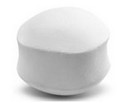SMA
Thermoplastics > Acrylates
| SMA exchange resins | |||||||||
In general, the exchange resins are composed of crosslinked polymers and functionalized capable of exchanging ions present in their particular structure with ions present in a solution in contact; This exchange takes place without any physical alteration in the resin. Likewise, are produced through a suspension polymerization process to produce spheres with diameters ranging from 0.5 to 1.2 mm, then the obtained copolymer is modified by inclusion of functional groups in their structure. The properties and characteristics of the end product depend on how the two mentioned steps are performed. |  | ||||||||
| Styrene maleic anhydride copolymer - Styrene maleic anhydride (SMA) | |||||||||
SMA resins are produced mainly from styrene and maleic anhydride. Styrene maleic anhydride (SMA thermoplastics) is a crystalline amorphous thermoplastic formed by free radical copolymerization of styrene and maleic anhydride. The polymer is formed by radical polymerization using an organic peroxide as the initiator. SMA copolymers are defined by the average ratio of styrene to repeating units of maleic acid (SMA resin). SMA resins are partially esterified polymera times. These resins contain a combination of anhydride functionality, monoester carboxylic acid.The main features of SMA copolymer are their transparent appearance, high heat resistance, high dimensional stability and specific reactivity of the anhydride groups. SMA have a high heat resistance that matches with families of styrene and ABS, provides high chemical resistance, high gloss and high melt viscosity. Some degrees of impact - modified SMA polymers also have excellent impact resistance. | |||||||||
| SMA Features | |||||||||
| |||||||||
| Among its general features can be highlighted the following | |||||||||
|  | ||||||||
| SMA as additives | |||||||||
SMA resins are well known for their high functionality and reactivity. For example, the anhydride portion can act as a hardener for epoxy formulations (heat - curable) (powder coatings). Anhydride groups in SMA are significantly less reactive to the absorption of atmospheric moisture and hydrolysis most anhydrides nonpolymeric. Ester resins have viscosities SMA low melting compared to SMA base resins, typical high - reactivity of the carboxylic acid functionality, improved solubility in many organic solvents and good compatibility with many polymeric and non - polymeric surfactants. |  | ||||||||
| Alloys - Blends | |||||||||
Many applications of the styrenic polymers require an increased temperature resistance, one of the most common ways to increase this temperature resistance is the addition of a comonomer which increases the rigidity of the polymer chain. Comonomers more commonly used for this case are maleic anhydride, maleimides and α-methylstyrene. Generally, αmetilestireno is the comonomer used to give more resistance to high temperature, its solubility characteristics with the styrene, and so no solvents are required as a special polymerization, thereby obtaining the styrene-co-αmetilestireno (SAMS).The SMA additives pellets can increase the yield and value of recycled or virgin resins such as acrylonitrile butadiene styrene (ABS) and polymethyl methacrylate (PMMA), to extend its thermal stability, improve the processing window and increase the polarity or adhesion at moderate cost compared to other additives and proprietary polymer modification techniques for these same resins families. With a high glass transition temperature (Tg) of 145-175 ° C, the granules SMA is a very cost effective way to increase the thermal efficiency of PMMA and ABS resins. You can improve all the properties such as heat deflection temperature (HDT), the continuous use temperature (CUT), the Vicat and thermal aging. | |||||||||
| SMA coupling | |||||||||
Manipulating the ratio of styrene to maleic anhydride to adjust the polarity. This block copolymer is miscible in a wide range of plastics, enabling it to be used as compatibilizer in multipolymer systems. SMA is ideal for engineering plastics compounds compatibilizer. SMA thermoplastic contains reactive groups that can help to create a mixture of polymers with optimum interfacial tension. The SMA thermoplastics plastics provide better long term stability, provide antistatic properties, give color and enhance mechanical properties. Loads in particular are useful tools in plastics for setting properties,adapting to the specific needs of each application. Although the charges are very beneficial for performance plastics, they bring some disadvantages and that is where the dispersing agents and coupling come into function. By selecting the dispersant or suitable coupling agent, one can maximize the properties and minimizing inconvenience to create materials with an optimal balance of performance and cost. |  | ||||||||
| Copolymers SMMA styrene- methylmethacrylate | |||||||||
The SMMA are styrenic copolymers with excellent transparency and optical properties, excellent resistance to sterilization by gamma radiation, beta and ETO. F ent polystyrene have improved light stability, clarity and toughness and is free of Bisphenol A, therefore can meet the par regulations the contact alimentare (FDA and European regulations) and for applications in the médicales industry (USP VI ). Regarding crystal PS have the same ease of similar transformation, but do not need drying , better resistance to UV light, with the same transparency, but have better mechanical properties, miemtras r especto the SAN has better light resistance, not presecado needs. You can use leftover mashed production without pollution problems. Some mixtures, have better impact. No doubt about the PMMA has better dimensional, lighter, better impact, similar transparency, stability and needs no drying is cheaper. Also regarding the PC is easier processability, has better transparency , does not need pre - drying is more economical ace, libero da Bisphenol A.It retains the characteristics of high transparency, scratch resistance and good behavior in large thicknesses similar to PMMA. Virtually no moisture absorption, which offers the advantage of avoiding drying pretreatment. Good processability and slightly larger than the PMMA chemical resistance. It is ideal for products with large thickness as thin walls. Among its general characteristics can include the following: They must contain at least 30% by weight of styrene parts to prevent degradation at temperatures near 250 ° C. Meet the requirements of transparent plastics with good mechanical properties, dimensional stability, scratch resistance and flexibility, f ácilad up processing (requires less temperature need not be dried, provides high gloss and xcelente and low density. It can be used both for injection and extrusion blow molding. Its uses are similar to those of PMMA, SAN or PS. It can replace PMMA resins, acrylic based polymers and other transparent polymers such as PC, the main advantage is a significant reduction in costs and a simpler (faster and less shrinkage) transformation. | |||||||||
| Styrene-divinylbenzene copolymers SDVB | |||||||||
Are very delicate copolymers made the amount of styrene and divinylbenzene must be tightly controlled, because small amounts of divinylbenzene enough to generate insoluble gels. SDVB based resins, and the availability and the low cost of the monomers, has good physical and chemical stability, such that is not readily degradable by oxidation or hydrolysis. Pair to the copolymerization via free radical used SDVB is l os monomers styrene and divinylbenzene, with emulsifying agent in solution poly (vinyl alcohol) (PVA), benzoyl peroxide as initiator. | |||||||||
| SAMS Copolymers styrene-α-methylstyrene | |||||||||
The SAMS are probably less known copolymers are very unstable copolymers made their polymerization must be tightly controlled to prevent degradation. Via free radical copolymerization is limited SAMS via solution or bulk for a number of reasons; to rriba of 61 ° C the α-methylstyrene homopolymer is unstable therefore copolymerization above 61 ° C is conditioned to amounts molar 2: 1 α-methylstyrene to styrene in the feed. Additionally, the copolymerization rate is affected by the concentration of α-methylstyrene and increases the formation of oligomers. these oligomersreduce the glass transition temperature causing problems at the stage of processing, during molding and extrusion. The α-methylstyrene homopolymer is used as a plasticizer in paints, waxes and adhesives. The monomer is also used to form a copolymer with methyl methacrylate, which has a high temperature of distortion. | |||||||||
| Acrylic Copolymer (AC) | |||||||||
Acrylic copolymers (AC) are transparent thermoplastic copolymers of ethylene and acrylate with outstanding low temperature flexibility and impact resistance. The two most important copolymers are ethylene-ethyl acrylate (EEA) and ethylene butyl acrylate-(EBA). They are produced by a free radical polymerization under high pressure. Since the reactivity is much higher than that of ethylene, more than just the end. The resulting heterogeneous molecular architecture provides good adhesion to polar and nonpolar substrates. It also provides a good compatibility with a wide variety of polymers. Small amounts of other monomers such as acrylic acid anhydride and male, are incorporated into the copolymer increases adhesion to polar substrates. The AC is often mixed with other thermoplastics such as PP, PE, PA, PET and PVC for improved performance and / or to improve performance. For example, domains dispersed ethylene acrylate. It is known that AC improve pigment dispersion and mineral fillers. Typical applications of AC include hot melt adhesives, plastics and foam products coextruded and extrusion sealable layers in flexible packaging films. | |||||||||
| Applications | |||||||||
SMA resin has excellent performance, so in the automotive industry has been widely used; also it becomes quickly in the field of powder coatings and leather products quickly. Base resins styrene and maleic anhydride (MA) in solid form or hydrolysed generally used as polymeric dispersants and surfactants. As molded plastic, the SMA / resin mixtures copolymers find use in the automotive industry for applications console and instrument panel. The SMA surface provides excellent adhesion to the polyurethane foam (PUR) used for padded panels instruments. SMA is an excellent compatibilizer for many resin mixtures which are normally immiscible. The SMA (ester) resins many products formulated as adhesives, solvent based coatings, overprint varnishes, printing inks, powder coatings, carpet cleaners and care products floors are also added. Function as polymeric dispersing agents and emulsifying agents, and crosslinkers high functionality. |  | ||||||||
